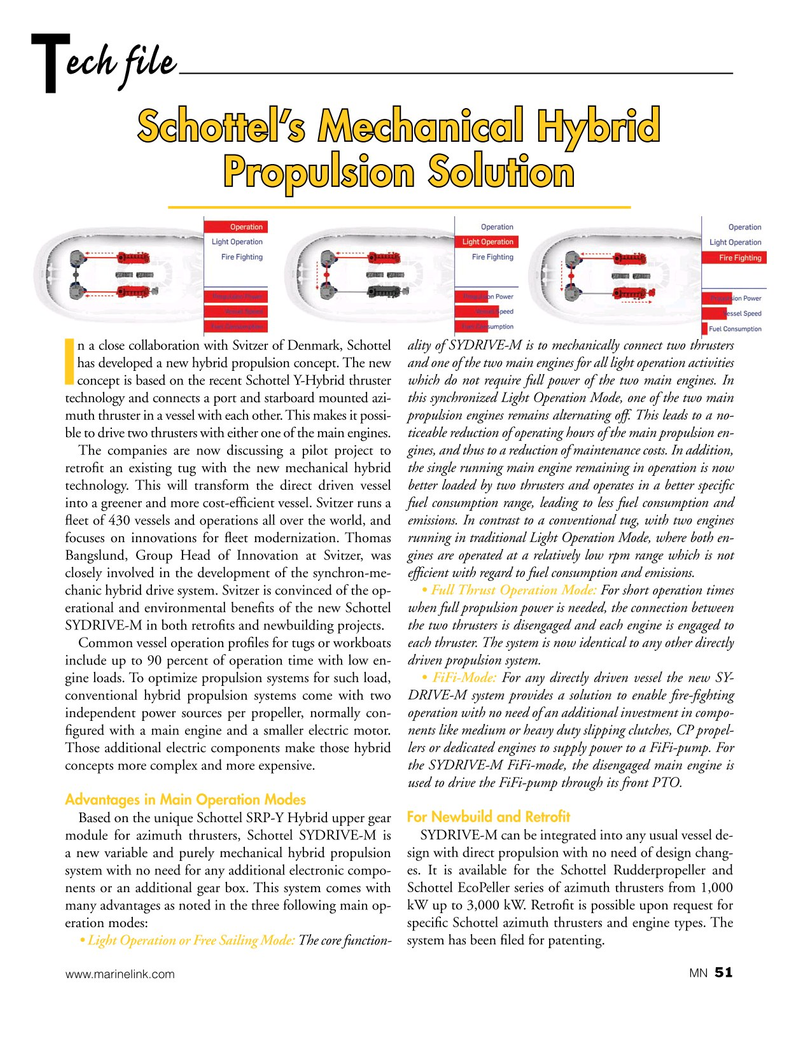
Page 51: of Marine News Magazine (March 2019)
Pushboats, Tugs & Assist Vessels
Read this page in Pdf, Flash or Html5 edition of March 2019 Marine News Magazine
ech file
T
Schottel’s Mechanical Hybrid
Propulsion Solution n a close collaboration with Svitzer of Denmark, Schottel ality of SYDRIVE-M is to mechanically connect two thrusters has developed a new hybrid propulsion concept. The new and one of the two main engines for all light operation activities concept is based on the recent Schottel Y-Hybrid thruster which do not require full power of the two main engines. In
I technology and connects a port and starboard mounted azi- this synchronized Light Operation Mode, one of the two main muth thruster in a vessel with each other. This makes it possi- propulsion engines remains alternating off. This leads to a no- ble to drive two thrusters with either one of the main engines. ticeable reduction of operating hours of the main propulsion en-
The companies are now discussing a pilot project to gines, and thus to a reduction of maintenance costs. In addition, retroft an existing tug with the new mechanical hybrid the single running main engine remaining in operation is now technology. This will transform the direct driven vessel better loaded by two thrusters and operates in a better specifc into a greener and more cost-effcient vessel. Svitzer runs a fuel consumption range, leading to less fuel consumption and feet of 430 vessels and operations all over the world, and emissions. In contrast to a conventional tug, with two engines focuses on innovations for feet modernization. Thomas running in traditional Light Operation Mode, where both en-
Bangslund, Group Head of Innovation at Svitzer, was gines are operated at a relatively low rpm range which is not closely involved in the development of the synchron-me- effcient with regard to fuel consumption and emissions.
chanic hybrid drive system. Svitzer is convinced of the op- • Full Thrust Operation Mode: For short operation times erational and environmental benefts of the new Schottel when full propulsion power is needed, the connection between
SYDRIVE-M in both retrofts and newbuilding projects. the two thrusters is disengaged and each engine is engaged to
Common vessel operation profles for tugs or workboats each thruster. The system is now identical to any other directly include up to 90 percent of operation time with low en- driven propulsion system.
gine loads. To optimize propulsion systems for such load, • FiFi-Mode: For any directly driven vessel the new SY- conventional hybrid propulsion systems come with two DRIVE-M system provides a solution to enable fre-fghting independent power sources per propeller, normally con- operation with no need of an additional investment in compo- fgured with a main engine and a smaller electric motor. nents like medium or heavy duty slipping clutches, CP propel-
Those additional electric components make those hybrid lers or dedicated engines to supply power to a FiFi-pump. For concepts more complex and more expensive. the SYDRIVE-M FiFi-mode, the disengaged main engine is used to drive the FiFi-pump through its front PTO.
Advantages in Main Operation Modes
Based on the unique Schottel SRP-Y Hybrid upper gear For Newbuild and Retroft module for azimuth thrusters, Schottel SYDRIVE-M is SYDRIVE-M can be integrated into any usual vessel de- a new variable and purely mechanical hybrid propulsion sign with direct propulsion with no need of design chang- system with no need for any additional electronic compo- es. It is available for the Schottel Rudderpropeller and nents or an additional gear box. This system comes with Schottel EcoPeller series of azimuth thrusters from 1,000 many advantages as noted in the three following main op- kW up to 3,000 kW. Retroft is possible upon request for eration modes: specifc Schottel azimuth thrusters and engine types. The • Light Operation or Free Sailing Mode: The core function- system has been fled for patenting. 51 www.marinelink.com MN

 50
50

 52
52
